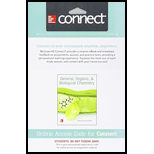
Concept explainers
(a)
Interpretation:
The structure corresponding to 4-methyl-1-hexene should be given.
Concept Introduction:
(b)
Interpretation:
The structure corresponding to 5-ethyl-2-methyl-2-heptene should be given.
Concept Introduction:
Alkenes are named in the same way as alkanes, but the alkenes are identified by the suffix −ene, replaced instead of the ending of the name of the parent alkane. The longest carbon chain should be numbered in a way that gives the double bond the lower number. Then the compound should be named using the first number assigned to the double bond. The names of the substituents should be written first in the alphabetic order with their position on the chain.
(c)
Interpretation:
The structure corresponding to 2,5-dimethyl-3-hexyne should be given.
Concept Introduction:
(d)
Interpretation:
The structure corresponding to 1-propylcyclobutene should be given.
Concept Introduction:
In the nomenclature of cycloalkenes, the double bond is always located between C-1 and C-2. And 1 is not mentioned in the name. The ring is then numbered in a way that the first substituent gets the lowest number.
(e)
Interpretation:
The structure corresponding to 1,3-cyclohexadiene should be given.
Concept Introduction:
In the nomenclature of cycloalkenes, the double bond is always located between C-1 and C-2. And 1 is not mentioned in the name. the ring is then numbered in a way that the first substituent getting the lowest number.
(f)
Interpretation:
The structure corresponding to 4-ethyl-1-decyne should be given.
Concept Introduction:
Alkynes are named in the same way as alkanes, but the alkynes are identified by the suffix −yne, replaced instead of the ending of the name of the parent alkane. The longest carbon chain should be numbered in a way that gives the triple bond the lower number. Then the compound should be named using the first number assigned to the triple bond. The names of the substituents should be written first in the alphabetic order with their position on the chain.
Want to see the full answer?
Check out a sample textbook solution
Chapter 13 Solutions
Connect 1-Semester Access Card for General, Organic, & Biological Chemistry
- Draw skeletal structure corresponding to each IUPAC name 1,2-dimethylcyclopentene 6-ethyl-2-octyne 3,3-dimethyl-1,4-pentadiene trans-5-methyl-2-hexene 5,6-dimethyl-2-heptyne 3,4,5,6-tetramethyl-1-decyne 4-methyl-1-hexene methylcyclohexenearrow_forwardDraw the open structures of the molecules named below according to the IUPAC naming system. 1-chloro-3-ethyl benzene 4- (tert-butyl) -5-ethyl octane 3-Methylpentanal (1E, 3Z, 5E) -5-chloro-6-phenyl hexa-1,3,5-trien-1-olarrow_forwardDraw structural formulas for these alkenes. (a) trans-2-Methyl-3-hexene (b) 2-Methyl-2-hexene (c) 2-Methyl-1-butene (d) 3-Ethyl-3-methyl-1-pentene (e) 2,3-Dimethyl-2-butene (f) cis-2-Pentene (g) (Z)-1-Chloropropene (h) 3-Methylcyclohexene (i) 1-Isopropyl-4-methylcyclohexene (j) (E)-2,6-Dimethyl-2,6-octadiene (k) 3-Cyclopropyl-1-propene (l) Cyclopropylethene (m) 2-Chloropropene (n) Tetrachloroethylene (o) 1-Chlorocyclohexenearrow_forward
- Explain why each is an incorrect IUPAC name and write the correct IUPAC name for the intended compound. (a) 1,3-Dimethylbutane (b) 4-Methylpentane (c) 2,2-Diethylbutane (d) 2-Ethyl-3-methylpentane (e) 2-Propylpentane (f) 2,2-Diethylheptane (g) 2,2-Dimethylcyclopropane (h) 1-Ethyl-5-methylcyclohexanearrow_forwardThe following names are incorrect by IUPAC rules. Determine the correct IUPAC name for each compound. a. 2-Ethyl-2-pentene b. 4,5-Dimethyl-4-hexene c. 3,5-Cyclopentadiene d. l,2-Dimethyl-4-cyclohexenearrow_forwardDraw the structures that correspond to the following names: cis-3-tert-Butylcyclohexanecarbaldehyde 3-Methyl-3-butenal 2- (1-Chloroethyl) -5-methylheptanalarrow_forward
- Name of the structure CH3-CH₂-CH2-CH-CH-CH-CH3 CH₂ CH3 CH3 CH3 O 4-ethyl-5,6-dimethylheptane O 2-ethyl-3-gladys-4-mertylmaytane O 4-ethyl-2,3-dimethylheptane O 2,2,4-trimethylhexane O 4-ethyl-2-methyl-3-methylheptane.arrow_forwardWhat is the IUPAC name of this compound? Br O 4-Bromo-3-ethyl-2,2,5,6-tetramethylheptane O 4-Bromo-5-ethyl-2,2,3,6-tetramethylheptane O 3-Bromo-5-ethyl-2,4,6-trimethylheptane O 3-Bromo-5-isoprpyl-2,4-dimethylheptane O 3-Bromo-5-ethyl-2,3,6-trimethylhexanearrow_forwardDraw the CONDENSED STRUCTURES corresponding to the following names:arrow_forward
- Draw a structure of each of the following from the systematic name provided. Structure Systematic Name 2,3,3,9-tetramethyldecane 1-iodo-2-methylcyclohexane 5-isopropyl-2,3-dimethyloctane tert-butylcyclopentane 3,5-dibromo-5-ethyl-2-methylheptane 2-fluoro-4-isopropyl-2-methylheptane Concentrati 2,2,4,5,6-pentamethyloctane 4-bromo-2-chloro-1-methylcyclohexane 1,1-dichloro-2-methylpropanearrow_forwardWhich molecule contains a triple bond?arrow_forwardDraw the structure of the given compounds. Identify if the given name is correct or incorrect. Write the word ACCURATE if it is correct. If not, then provide the exact IUPAC Name. 1-ETHYLCYCLOPENT-2-ENE 7-HYDROXYNON-3-ENE 4-ETHYL-5,5-DIMETHYLNON-8-EN-1-YNE 7-BUTYNYLDODEC-1-ENE 6-PROPYLCYCOHEPTENEarrow_forward
 Organic ChemistryChemistryISBN:9781305580350Author:William H. Brown, Brent L. Iverson, Eric Anslyn, Christopher S. FootePublisher:Cengage Learning
Organic ChemistryChemistryISBN:9781305580350Author:William H. Brown, Brent L. Iverson, Eric Anslyn, Christopher S. FootePublisher:Cengage Learning Organic And Biological ChemistryChemistryISBN:9781305081079Author:STOKER, H. Stephen (howard Stephen)Publisher:Cengage Learning,
Organic And Biological ChemistryChemistryISBN:9781305081079Author:STOKER, H. Stephen (howard Stephen)Publisher:Cengage Learning, General, Organic, and Biological ChemistryChemistryISBN:9781285853918Author:H. Stephen StokerPublisher:Cengage Learning
General, Organic, and Biological ChemistryChemistryISBN:9781285853918Author:H. Stephen StokerPublisher:Cengage Learning Introductory Chemistry: A FoundationChemistryISBN:9781337399425Author:Steven S. Zumdahl, Donald J. DeCostePublisher:Cengage Learning
Introductory Chemistry: A FoundationChemistryISBN:9781337399425Author:Steven S. Zumdahl, Donald J. DeCostePublisher:Cengage Learning



